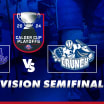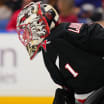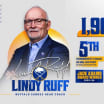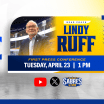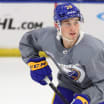Jay McKee was in the penalty box for Jason Pominville's Game 5 goal against the Ottawa Senators in 2006. He was on the team in 1999 when Jason Woolley won Game 1 of the Stanley Cup Final in overtime.
So, how is it that when McKee was asked to name the greatest goal in Buffalo Sabres history, his mind went to a game he wasn't even a part of - and a goal that didn't technically count?
Well, there was just something special about The Aud.
Sabres Classics: Remembering The Aud
Final game at The Aud airs Tuesday on MSG at 8 p.m.
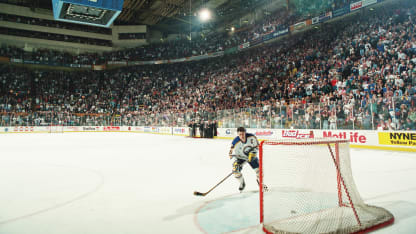
McKee was only four days removed from making his NHL debut when the Sabres closed Buffalo Memorial Auditorium with a 4-1 victory over the Hartford Whalers on April 14, 1996. But he had returned home to Ontario to finish his schooling and thus tuned into the game on television.
Once the win was complete, the lights were dimmed for alumni and then-current members of the Sabres to take their last laps in their old home until, finally, captain Pat LaFontaine skated to the blue paint, waved to the crowd, and tapped in the ceremonial final goal.
Watch: Youtube Video
"Just the whole idea of shutting down the lights and having one of your legends score the last goal in The Aud, I think that was a pretty neat touch to close out an arena with an amazing history behind it and a lot of tradition and so many memories," McKee said.
Of course, that goal won't show up in the box score. Officially, the last goal scored in The Aud belonged to Michael Peca, then in his second season with the team.
"Not just the last Sabres goal but last goal ever scored in The Aud," Peca pointed out. "That's something I'll never forget."
The unforgettable night will be replayed Tuesday at 8 p.m. on MSG. Until then, let's hear from Sabres legends about just what made The Aud so special.
The fans
Sabres Memories: The Aud
Don Luce refers to The Aud as the Sabres' "secret weapon" during his playing days in the 1970s. There was a small ice surface that catered to the team's abilities, forgiving boards that swayed upon contact, and a spot in the dasher boards that - when kicked just right - could send the puck into the slot for a scoring chance.
We're going to get to all that. But the real weapon in The Aud, Luce says, was the crowd.
"Just the energy of the fans," Luce said. "They energized the team. I don't know if they knew it or not, but to me that was a special time and I don't know if they'll ever have it again where the fans and players were one. I don't think the fans realized how important they were to us as a motivation. When we lost, they lost. When we won, they won. It wasn't them or us. It was just us."
The steepness of The Aud - with its seats painted vividly from bottom to top, gold, red, blue, and orange - made it feel as if the fans were right on top of the action. Those who played there loved it.
Fred Stanfield (forward, 1974-78) - "It felt like they were coming over at you, but it was a good feeling. Because in The Aud it went kind of straight up and they were looking down on you, so it was a great place to watch a game."
Jim Lorentz (forward, 1971-78) - "In those days, it was the same people there every night, every game. They were always in the same seats and you sort of became acquainted with people who sat around the bench. The Knoxes sat right up behind the bench and [general manager] Punch [Imlach] sat down in the corner, down to our left. So, I remember that. You saw the same people there all the time and just the incredible excitement in that building."
Mike Robitaille (defenseman, 1971-74) - "You come out on the ice and you could smell the other guy's breath at the other end. I mean, you're right on top of things. But I'm telling you, dead honest, this city and its fans, and the building was so tight that when you came out on the ice for warmups you literally know - personally know - a lot of people that were at warmups, down near ice level, sitting in the golds. ... These were my friends off the ice. It was that close. You knew people. You knew people by name. Remember, we didn't have helmets. You knew this ugly mug because it was there."
Rene Robert (forward, 1972-79) - "The thing I liked about the old Aud was that people were so close that you could really see the expressions on their faces when something happened."
Dave Hannan (forward, 1992-96) - "Probably my favorite rink because the fans were right on top of you. You didn't have much time to make a play. Sabres fans were so loyal and they just packed the place and it was loud."
During his first training camp with the Sabres, Danny Gare noted the steepness and voyaged up to the top level - "the oranges," as it's still known today.
Danny Gare (forward, 1974 - 1981) -"So, I walk all the way up to the top of the oranges, and I'm sitting at the top seat of the oranges, and I was like, 'Boy, I don't know how these people - if I fell, I could fall right over the balcony and down onto the fans.' I said, 'Wouldn't it be cool to score a goal and see how these fans react?' It was just a little bit of a thought process and kind of amazed at the building because I've never seen a building like that."
The quirks
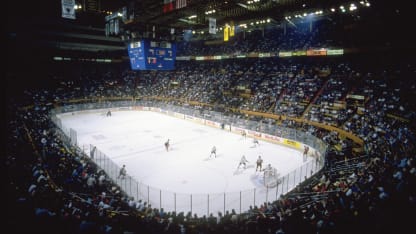
Those who played in The Aud through the decades remember their journey into the building, a walk through the parking lot that exposed players to the harsh Buffalo winters.
Gerry Meehan (forward, 1970-74) - "Absolutely, both as a player and as a general manager, I remember very well what it was like. And there wasn't any crew out there cleaning it up. Of course, how could you? It's ice and snow falling from the skyway. It was an experience, but we got through it and walked in that side door and went off to play."
Robert: "We had to walk through mud to get to the rink."
The quirks didn't end once inside. The home dressing room was cramped, true for many of the era. A tightly wound spiral staircase led up to the team's weight room.
Stanfield:"The locker room wasn't very big then, so we were very close and we were kind of jammed in. They had the windy stairs for the weight room. It had a lot of character to it, but we were used to small dressing rooms then. I started with original six, so you didn't have a big room. So I felt at home in that dressing room at The Aud."
Robert:"Our dressing room was not the Waldorf Astoria by any means. We had a spiral stairway that went upstairs to where our little gym was. We had holes in one cement wall where the rats would come in and feed. It was pretty interesting."
On the ice, the Sabres used the building's oddities to their advantage. The ice surface was smaller than the traditional 200 x 185 dimensions, which not only suited a large defense corps featuring names like Jerry Korab and Jim Schoenfeld but also forced the Sabres to learn to play quickly, which translated well to larger rinks on the road.
Meehan:"I had played my entire development career on a regulation sized rink, which was 200x85. The Aud was, I think, 194 or 195 by 85 or 83, whatever it might've been. But that little difference made a fair amount of difference and put a real focus and an emphasis on being able to move the puck quickly and handle the puck in traffic and things like that."
Gare: "We'd go on the road and you'd get a few more feet on each end. That's why we used to beat Montreal, I always felt, or Toronto, because we were such a good skating team and that little extra feet would give you that extra room to get to the net or be open, whatever it was."
The glass, meanwhile, swayed upon impact, allowing players to bounce off hits into the boards. Craig Ramsay suggested the glass at The Aud helped him set the franchise record for consecutive games played (776).
Ramsay (forward, 1971 - 1985) - "The glass moved a lot. I'd move into glass and it'd take the hit and fling me back out again. That's how I survived some of the big hits. Saved me some injuries."
Luce: "It probably swayed about two feet, a foot and a half, something like that. It was considerable. But it actually it probably was safer for us then, to help absorb the checks and stuff. It wasn't a bad thing. The boards now are so stiff and hard, you really get hammered when you get hammered into the boards nowadays."
The most infamous feature was a spot along the boards that could be kicked out from behind, a tactic taken advantage of by a member of the team's equipment staff, Encil "Porky" Palmer. By most accounts, Palmer would kick that spot as the puck skipped by to send it toward the slot for a scoring chance.
Gare:"When the puck would go around the boards behind the net, he'd press on a dasher where the board came out. He'd put his foot on it and it'd come out about a quarter inch. The puck would hit it and it'd come out to the front of the net, and we scored a lot of goals like that. It was a set play."
Robitaille: "Porky Palmer was a bit of a dancer, you know? Back there, he'd just give it a kick at the right time. You'd only have to move it maybe a half an inch, quarter inch, and that was enough to catch the puck. I mean, there were a lot of little tricks that were going on. This happened in the NHL for many, many years, all kinds of little tricks like that. Like, you know, turning off the ice machine to slow the ice down for a fast team. Montreal's coming in, you don't give them blazing fast ice. You slow it, down slow them down to our speed. They were always thinking. Imlach was pretty crafty like that. He had a lot of little tricks."
The legacy
RJ shares his favorite memories of The Aud
For all its oddities, The Aud was the beloved home to three decades of Sabres players and fans.
Dominik Hasek (goalie, 1992 - 2001) -"I loved to play in the Aud. I'm very serious when I say, I have to say that it was a better building than Montreal Forum, it was a better building than Toronto Garden."
Peca: "My first NHL game ever was in the Montreal Forum, and around that same time I got to play in the Boston Garden. I always viewed The Aud in that group. It had so much energy, it had so much character. The fans were right on glass. … It just felt like a place where you couldn't wait to get on the ice and play."
Ramsay: "The noise, atmosphere, feeling. It was special for us and difficult for visiting teams. I remember my son shooting there when he was four. Van Miller came out and did an interview with him, put it on the news. Buffalo was a great place to be and The Aud was a hell of a place to play."
Luce: "It was a great old building. It was our home and it treated us really well."

